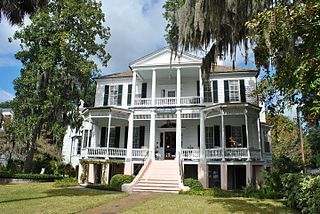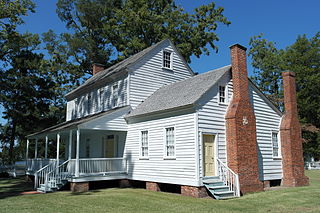
The Hunting Island Light is located in Hunting Island State Park on Hunting Island near Beaufort, South Carolina. Although no longer used as a functioning lighthouse, the tower is a fixture at the state park and is open to visitors. It was named to the National Register of Historic Places in 1970.

The Nathaniel Russell House is a historic house at 51 Meeting Street in Charleston, South Carolina, United States. Built in 1808 by wealthy merchant and slave trader Nathaniel Russell, it is recognized as one of America's most important neoclassical houses. It was designated a National Historic Landmark in 1973.

The William Gibbes House is a historic house at 64 South Battery in Charleston, South Carolina. Built about 1772, it is one of the nation's finest examples of classical Georgian architecture. It was declared a National Historic Landmark in 1970.

The Elizabeth Cady Stanton House is a historic house at 32 Washington Street in the village of Seneca Falls, New York. Built before 1830, it was the home of suffragist Elizabeth Cady Stanton (1815-1902) from 1847 to 1862. It is now a historic house museum as part of Women's Rights National Historical Park. It was declared a National Historic Landmark in 1965.

Borough House Plantation, also known as Borough House, Hillcrest Plantation and Anderson Place, is an historic plantation on South Carolina Highway 261, 0.8 miles (1.3 km) north of its intersection with U.S. Route 76/US Route 378 in Stateburg, in the High Hills of Santee near Sumter, South Carolina. A National Historic Landmark, the plantation is noted as the largest assemblage of high-style pisé structures in the United States. The main house and six buildings on the plantation were built using this technique, beginning in 1821. The plantation is also notable as the home of Confederate Army General Richard H. Anderson.

Summerseat, also known as the George Clymer House and Thomas Barclay House, is a historic house museum at Hillcrest and Legion Avenues in Morrisville, Bucks County, Pennsylvania. Built about 1770, it is the only house known to have been owned by two signers of the United States Declaration of Independence, George Clymer and Robert Morris, and as a headquarters of General George Washington during the American Revolutionary War. The house is now managed by the Morrisville Historical Society, which offers tours. It was designated a National Historic Landmark in 1965.

The William Aiken House and Associated Railroad Structures make up a National Historic Landmark District in Charleston, South Carolina, that contains structures of South Carolina Canal and Railroad Company and the home of the company's founder, William Aiken. These structures make up one of the largest collection of surviving pre-Civil War railroad depot facilities in the United States. The district was declared a National Historic Landmark in 1963.

The Barnwell-Gough House, also known as Old Barnwell House, is a house built in Beaufort, South Carolina in 1789.

John A. Cuthbert House is a house built in 1811 in Beaufort. It was listed on the National Register of Historic Places in 1972.

Bethesda Presbyterian Church is a historic church at 502 DeKalb Street in Camden, South Carolina. A National Historic Landmark, the main church building was built in 1822 and is one of few surviving churches designed by 19th-century American architect Robert Mills. The current minister is Rev. Jim Davis.

Union Tavern is a historic tavern and workshop on Broad Street in Milton, North Carolina. It is a rare example of a well-preserved early 19th-century Federal period tavern, and is further notable as the workshop of Thomas Day, a free person of color who was one of North Carolina's leading cabinetmakers. The building was designated a National Historic Landmark in 1975. It is located in the Milton Historic District.

The Nash-Hooper House, also known as the William Hooper House, is a historic house at 118 West Tryon Street in Hillsborough, North Carolina. Built in 1772 by American Revolutionary War general Francis Nash, it was home from 1782–90 to William Hooper, a signer of the United States Declaration of Independence. It is the only known home of Hooper's to survive, and was declared a National Historic Landmark in 1971. It is located in the Hillsborough Historic District; it is a private residence, and is not normally open to the public.

The Chappelle Administration Building, on the campus of Allen University in Columbia, South Carolina, was designed by John Anderson Lankford, known as the "dean of black architects." The building name has been spelled Chapelle Administration Building in HABS and NPS reports. It was declared a National Historic Landmark in 1976, cited as one Lankford's most important works.

The Robert Smalls House is a historic house at 511 Prince Street in Beaufort, South Carolina. Built in 1843 and altered several times, the house was designated a National Historic Landmark in 1974 for its association with Robert Smalls (1839-1915). Smalls, born into slavery, achieved notice for commandeering the CSS Planter and sailing her to freedom during the American Civil War. After the war he represented South Carolina in the United States House of Representatives during Reconstruction.

John Mark Verdier House, also known as Lafayette Building, is a building in Beaufort, South Carolina. It was built by John Mark Verdier, a French Huguenot, in 1804. The house typified Beaufort's gracious antebellum architectural style. It was a focal point of the town, a visible statement reflecting Verdier's significant wealth from trading indigo and growing sea island cotton.

Marshlands, also known as the James Robert Verdier House, is a historic house at 501 Pinckney Street in Beaufort, South Carolina. Built about 1814, it is a high quality and well-preserved example of early Beaufort architecture, showing both Adamesque and West Indian stylistic influences. It is also notable as a home of Dr. James Robert Verdier, who discovered a treatment for yellow fever. It was designated a National Historic Landmark in 1973 for its architectural significance.

Bonner House is a historic home located at Bath, Beaufort County, North Carolina. It was built about 1835, and is a two-story frame dwelling with a one-story wing and rear shed addition. It sits on a brick pier foundation and has a side-hall plan. It is on land once owned by John Lawson, explorer and founder of Bath.

Hillsborough Historic District is a national historic district located at Hillsborough, Orange County, North Carolina. The district encompasses 529 contributing buildings, 9 contributing sites, 13 contributing structures, and 2 contributing objects in the central business district and surrounding residential sections of Hillsborough. The district includes buildings dating to the late-18th and early-20th century and includes notable examples of Federal, Greek Revival, and Italianate style architecture. Located in the district are the separately listed Burwell School, Eagle Lodge, Hazel-Nash House, Heartsease, Montrose, Nash Law Office, Nash-Hooper House, Old Orange County Courthouse, Poplar Hill, Ruffin-Roulhac House, Sans Souci, and St. Matthew's Episcopal Church and Churchyard. Other notable buildings include Seven Hearths, the Presbyterian Church (1815-1816), Methodist Church (1859-1860), First Baptist Church (1862-1870), Twin Chimneys, and the Berry Brick House.

Westend is a temple-fronted house near Trevilians, Virginia, United States. Built in 1849, the house's design refers to the Classical Revival style, representing an extension of the Jeffersonian ideal of classical architecture. The house was built for Mrs. Susan Dabney Morris Watson on a property that she had inherited from her late husband. The building project was supervised by Colonel James Magruder. The house was the centerpiece of a substantial plantation, and a number of dependencies, including slave dwellings, survive. Westend remains in the ownership of the descendants of Mrs. Watson.

Sans Souci is a historic home located at Hillsborough, Orange County, North Carolina. It was built about 1813, as two-story, three bay, frame dwelling with a gable roof and set on a brick foundation. Later additions included 1+1⁄2-story flanking wings added in the Federal period and a Greek Revival shed addition built in the mid-19th century across the rear of the main block and the east wing. Also on the property are the contributing kitchen, office, and servant's quarters.
























